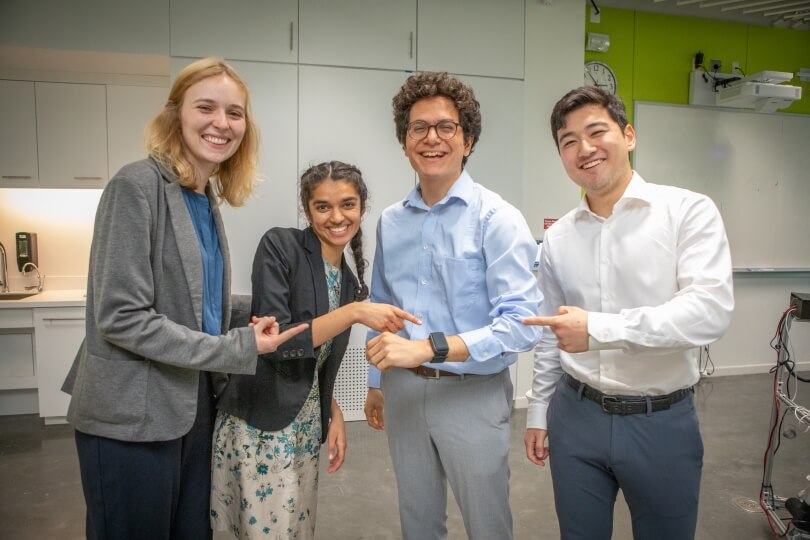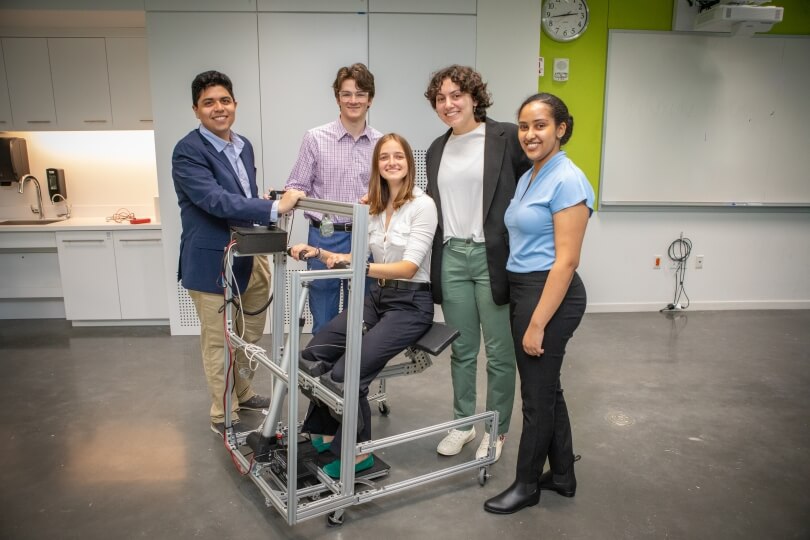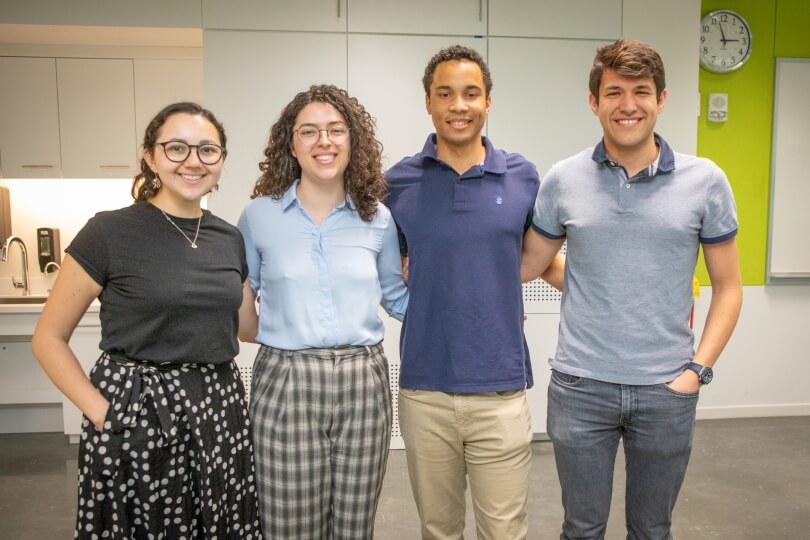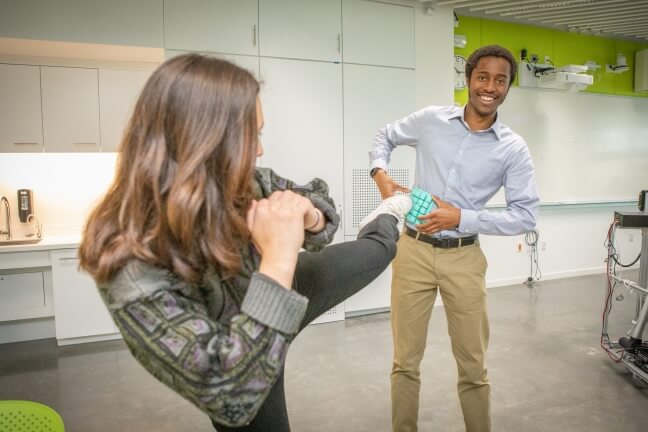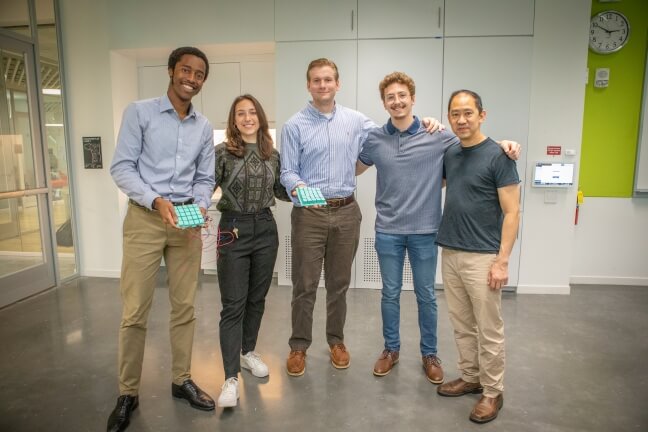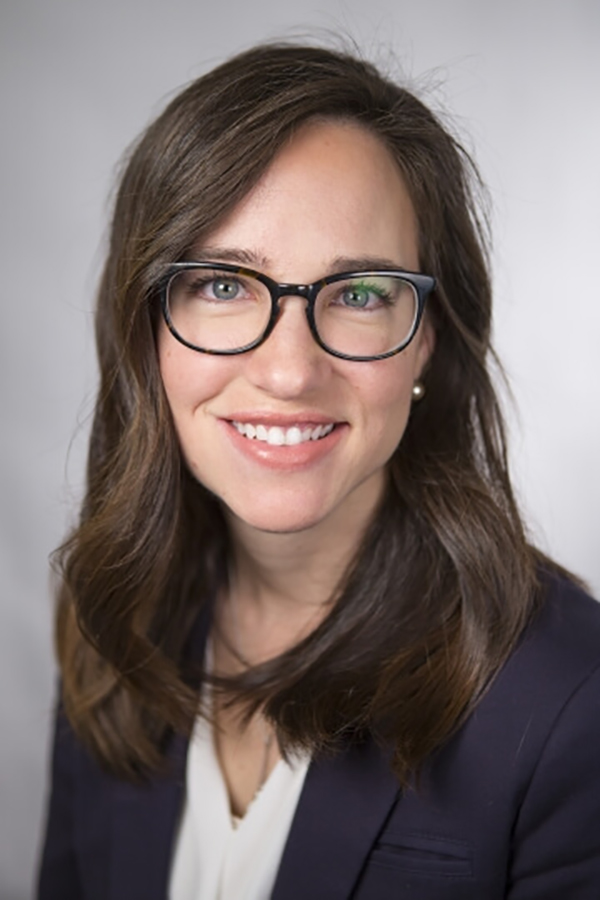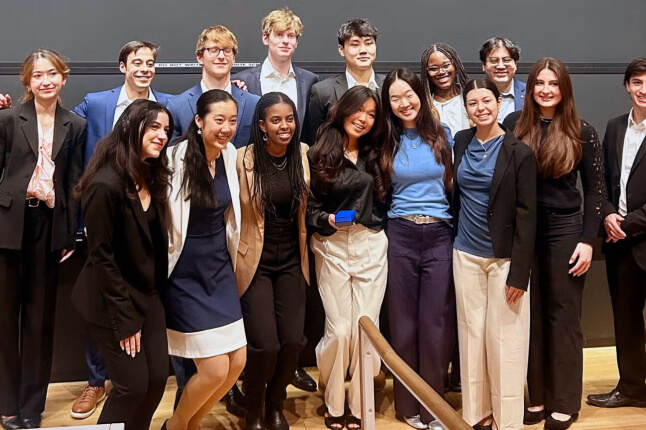News
ES227 team HeartStep: Maycee Wieczorek, Harini Kannan, Daniel Mhrous and Joey Liu. (Eliza Grinnell/SEAS)
Could a tunnel of light detect contact with a human body? What can monitoring the rigidity of wrist muscles tell us about Parkinson’s disease? Can commercial wearable devices be adapted for clinical research? Would an automated lifting device help the elderly more safely move throughout their homes?
Students at the Harvard John A. Paulson School of Engineering and Applied Sciences (SEAS) tackled all four of these questions in “ES227: Medical Device Design.” The course, co-taught by Conor Walsh, Paul A. Maeder Professor of Engineering and Applied Sciences, and Linsey Moyer, Associate Director of Undergraduate Studies in Biomedical Engineering, along with teaching fellows Mark Etzelmueller and Prabhat Pathak, took students through the entire device design process. It’s the first time ES227 has been offered in four years, and first time ever at the Science and Engineering Complex (SEC).
“We’re excited that we have the course offered again,” Walsh said. “Our students all appreciate the idea of applying what they’ve learned in other classes to real-world design projects and working with real-world stakeholders.”
Walsh and Moyer divided the class into four groups, each of which was given a broad medical challenge. The course then journeyed through all the design stages, from defining the problem and key stakeholders, to iterating on and testing potential solutions, to building a prototype.
“At the beginning we had to put the brakes on their desire to design immediately and get them to spend more time interviewing stakeholders and understanding the landscape of the problem,” Moyer said.
ES227 team UpRight: Ruben Fonseca, Lachlain McGranahan, Sofia Castore, Katherine Pane and Bersabeh Kelkai. (Eliza Grinnell/SEAS)
The class divided the semester roughly into thirds. The first third focused on problem identification, followed by ideation and selection of a final project. The third stage focused on implementation and prototyping, with classes often working as open lab time.
“If we brought any engineering solutions to them in the first month and a half, they’d say, ‘Nope, we’re not talking about that. Keep defining your problem,’” said Sofia Castore, a junior mechanical-engineering concentrator. “It was a lot of visualizing something and making it come to life. A lot of our classes are theoretical, and you can theorize all you want, but that’s not really what engineering is. At the end of the day, you need to actually build something and make sure it actually works.”
With the problem and stakeholders defined, each group then had the freedom to come up with a solution. Castore and third-year mechanical engineering student Lachlain McGranahan helped design UpRight, a freestanding device that uses a linear actuator and foot pedal to raise a person from a sitting to standing position. While such devices can be found in senior care homes, McGranahan’s team built one that could be used without supervision in the home.
“There’s nobody watching to make sure they’re not injuring themselves, so being able to have something affordable enough to send home with them is really powerful,” McGranahan said. “One thing Conor really stressed early on in the course was forgetting about what you wanted the final product to be. Forget about actually thinking about designs, and just inform yourself as much as possible about what the problem is. That’s really helpful because if you just dive right into the solution, you don’t know what you’re looking for.”
ES227 team SPARC: Chelsey Campillo Rodriguez, Sarah Cavanagh, Daniel Smith and Marcel Torné Villasevil. (Eliza Grinnell/SEAS)
McGranahan’s group included multiple mechanical engineering students, leading to a mechanical solution. But another team -- consisting of bioengineering and computer science graduate students -- tackled their challenge by developing algorithms to quantify rigidity in Parkinson's Disease patients. They used novel, wearable strain sensors that were developed at Harvard University and the Wyss Institute.
"We gravitated towards a more data-driven project based on our collective computational interests,” said Sarah Cavanagh, a G1 Ph.D. student in bioengineering. “It was a really unique experience. Instead of taking a more traditional class, with quizzes and exams, this class was more like a semester-long research project.”
Applying theory to practical design was a recurring theme among students’ favorite aspects of the class. Learning systems thinking, the process of turning an open-ended challenge into a clearly defined problem with key stakeholders that informs the specific solution, was another.
Harini Kannan’s team, HeartStep Solutions, built a low-cost heart rate monitor and accelerometer that can collect data over long periods of time, making it a more suitable wearable device for research and medical intervention purposes.
“The application to the real world and being able to think about something and propose and develop very out-of-the-box solutions is definitely different from my more traditional mechanical engineering courses,” said Kannan, a third-year student. “The first third of this class was spent learning about the background of the problem and current devices on the market. That’s a really valuable skill I can take to my later engineering courses and beyond.”
RoundHouse Technologies created a photoreceptive sensor that can register the force of impact. It’s meant to record kicks in taekwondo competitions, in which points are scored by registering kicks to the body shield or headgear. RoundHouse’s sensors project an optical tunnel, then create an impact score based on light deformation.
Roundhouse Technologies members Kade Kelsch, left, and Olisaneme Okonkwo demonstrate their optical tunnel sensor. (Eliza Grinnell/SEAS)
ES227 team Roundhouse Technologies: Olisaneme Okonkwo, Kade Kelsch, Clayton Donhauser and Nathaniel DeLucca, with Taekwondo master Dan Chuang. (Eliza Grinnell/SEAS)
“The force of the impact changes the shape of the tunnel,” said Nathaniel DeLucca, a third-year mechanical engineering concentrator. “By reducing the cross-sectional area of the tunnel, you’re reducing the amount of light that can pass through the tunnel.”
Fueled by the success of this semester, Walsh says that the goal is to have the course offered each year going forward.
“Gaining more intuition from a design perspective is something that can uniquely be gained from this class,” said Olisaname Okonkwo, a third-year bioengineering student on team RoundHouse Technologies. “A lot of other classes are about learning calculations and solving problem sets, but this was solving a really broad problem and really understanding how to break down problems into pieces we can find solutions for.”
Topics: Academics, Bioengineering, Computer Science, Materials Science & Mechanical Engineering, Optics / Photonics, Robotics, Technology
Cutting-edge science delivered direct to your inbox.
Join the Harvard SEAS mailing list.
Scientist Profiles
Linsey Moyer
Staff Co-Director of Undergraduate Studies in Biomedical Engineering
Press Contact
Matt Goisman | mgoisman@g.harvard.edu
